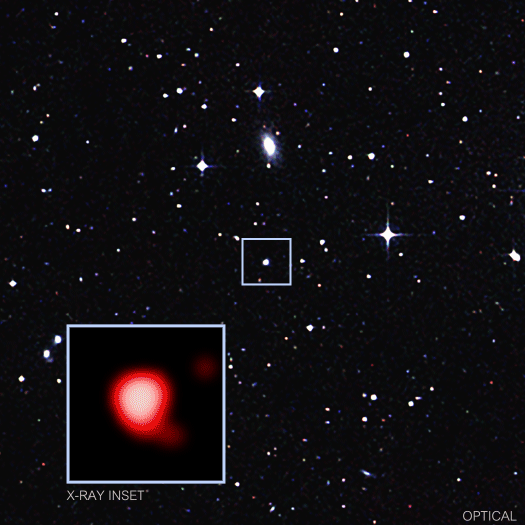Scientists Discover Black Hole Has Three Hot Meals a Day
A supermassive black hole is blasting out X-rays about every nine hours, according to data from NASA's Chandra X-ray Observatory and ESA's XMM-Newton, as described in our latest press release. This indicates that this black hole, containing about 400,000 times the mass of our Sun, is consuming significant amounts of material about three times per day.
The main panel of this graphic is a visible light image taken by the Digitized Sky Survey (DSS) around the galaxy known as GSN 069, located in the center of the image. The inset gives a time-lapse of Chandra data taken over a period of about 20 hours on February 14 and 15, 2019, centered on the X-ray source in the middle of GSN 069. The sequence runs in a loop to show that the X-ray brightness of the source changes regularly and dramatically over the Chandra observation. Three X-ray eruptions are observed. (Note that to clearly show the Chandra source is located in GSN 069, the size of the box in the center of the DSS image is about ten times larger than the Chandra field in the inset.)
XMM-Newton was the first to observe this phenomenon in GSN 069 with the detection of two bursts on December 24, 2018. Researchers then followed up with more XMM-Newton observations on January 16 and 17, 2019, and found five outbursts. The Chandra observations less than a month later — on February 14 and 15 — revealed an additional three outbursts.
These repetitive outbursts are evidence that the supermassive black hole at the center of GSN 069, located 250 million light years from Earth, is consuming about four Moons' worth of material about three times a day. That's equivalent to almost a million billion billion pounds going into the black hole per feeding.
While scientists had previously found two "stellar-mass" black holes (that weigh about 10 times the Sun's mass) occasionally undergoing regular outbursts before, this behavior has never been detected from a supermassive black hole until now.
During the outbursts the X-ray emission detected by Chandra becomes about 20 times brighter than during the quiet times. The temperature of gas falling towards the black hole also climbs, from about one million degrees Fahrenheit during the quiet periods to about 2.5 million degrees Fahrenheit during the outbursts. The temperature of the latter is similar to that of gas found around most actively growing supermassive black holes.
The origin of this hot gas has been a long-standing mystery because it appears to be too hot to be associated with the disk of infalling matter surrounding the black holes. Although its origin is also a mystery in GSN 069, the ability to study a supermassive black hole where hot gas repeatedly forms then disappears may provide important clues.
The Chandra data were crucial for this study because they were able to show that the X-ray source is located in the center of the host galaxy, which is where a supermassive black hole is expected to be. The combination of data from Chandra and XMM-Newton implies that the size and duration of the black hole's meals have decreased slightly, and the gap between the meals has increased. Future observations will be crucial to see if the trend continues.
A paper describing these results, with lead author Giovanni Minuitti (Center for Astrobiology (CAB, CSIC-INTA) in Spain), appeared in the September 11, 2019 issue of the journal Nature. NASA's Marshall Space Flight Center manages the Chandra program. The Smithsonian Astrophysical Observatory's Chandra X-ray Center controls science and flight operations from Cambridge, Massachusetts.
Category:
- Log in to post comments

